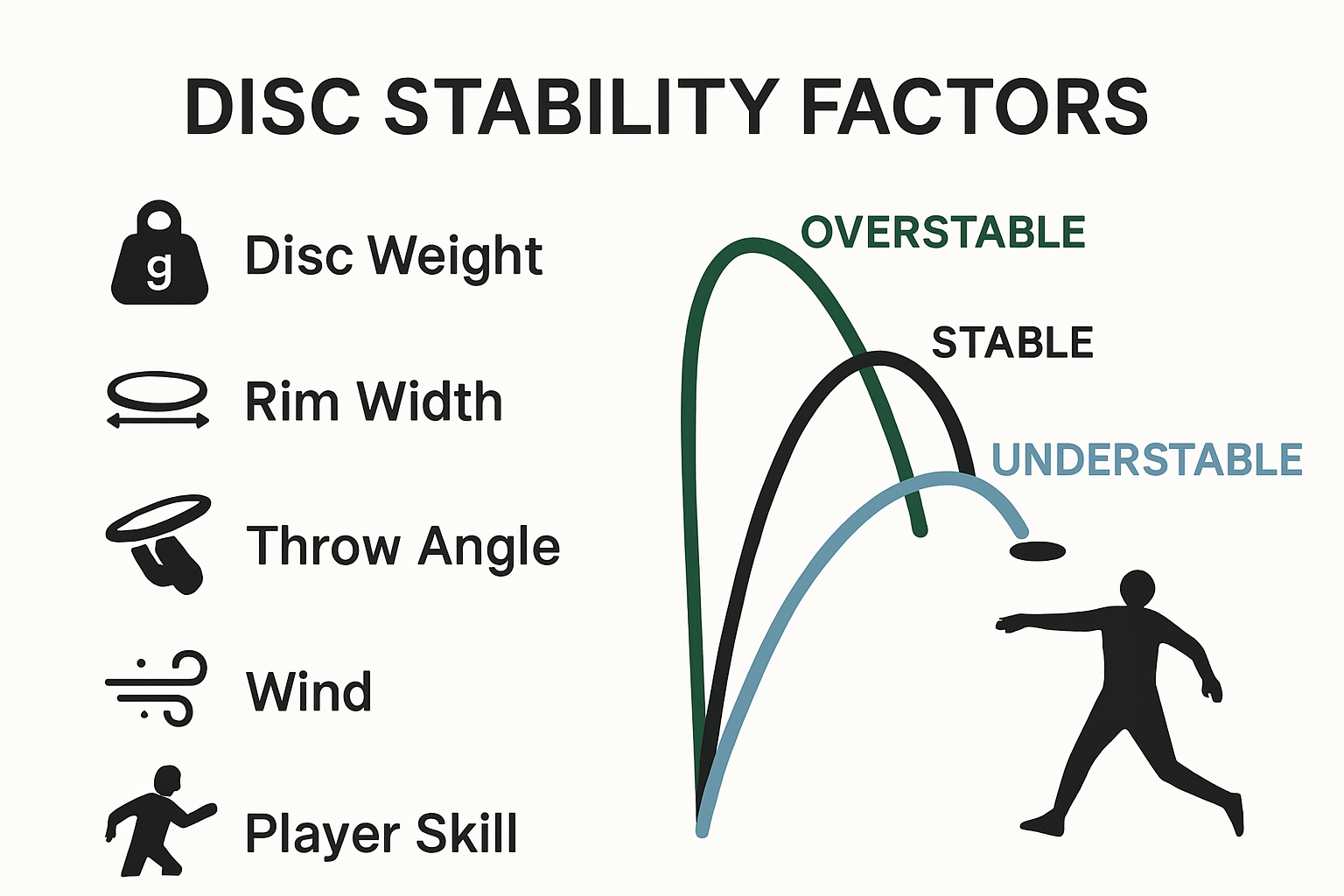
Understanding Disc Golf Disc Stability: A Complete Guide
Disc stability shapes every throw in disc golf. A single disc can fly perfectly straight or veer wildly sideways just by its stability rating, and the difference is more dramatic than most players expect. Some discs can turn up to 5 points more than others on the flight rating charts. Most assume picking any disc is fine for casual play, but disc stability is actually the secret behind precision, distance, and control for everyone from beginners to tournament champions.
Table of Contents
- What Is Disc Stability In Disc Golf?
- The Importance Of Disc Stability For Players
- How Aerodynamics Impacts Disc Stability
- Key Factors Influencing Disc Stability
- Choosing The Right Disc Based On Stability
Quick Summary
| Takeaway | Explanation |
|---|---|
| Understand disc stability ratings | Disc stability is defined by ratings of turn and fade that help predict flight paths. |
| Choose discs based on skill level | Beginners should use understable discs, while advanced players can manage a combination of disc types. |
| Master aerodynamics for better throws | Knowing how disc design affects flight helps players optimize their throws under varying conditions. |
| Practice diverse throwing techniques | Experimenting with different stability types enhances control and shot outcomes on the course. |
| Strategically select discs for specific courses | Consider factors like terrain, wind, and personal technique to improve overall performance. |
What is Disc Stability in Disc Golf?
Disc stability is a fundamental concept in disc golf that describes how a disc behaves during its flight path. Unlike traditional golf where clubs determine shot characteristics, in disc golf, the disc itself plays a crucial role in determining trajectory and performance. Understanding disc stability helps players select the right disc for specific throwing techniques and course conditions.
The Physics of Disc Flight
At its core, disc stability relates to how a disc moves through the air based on its design and aerodynamic properties. According to the Professional Disc Golf Association, disc stability is measured through two key flight ratings: turn and fade.
- Turn indicates the disc’s tendency to move right during the initial high-speed portion of flight for a right-handed backhand throw
- Fade describes the disc’s leftward movement as it slows down at the end of its trajectory
These ratings help players understand a disc’s potential path and choose equipment matching their throwing style. Flight numbers typically range from 0 to -5 or 0 to 5, with lower negative turn values indicating more understable discs and higher fade values representing more overstable discs.
Types of Disc Stability
Disc golf enthusiasts recognize three primary stability categories:
- Overstable Discs: Strongly resist turning and fade hard left for right-handed backhand throws
- Stable Discs: Maintain a relatively straight flight path with minimal turning or fading
- Understable Discs: More likely to turn right during high-speed throws before fading back
Mastering disc stability allows players to make strategic shot selections and improve overall performance. Learn more about disc golf fundamentals to enhance your understanding of this dynamic sport.
The following table summarizes the three primary types of disc stability in disc golf, helping players quickly identify and compare their key flight characteristics.
| Stability Type | Flight Behavior | Typical Use Case |
|---|---|---|
| Overstable | Resists turning, fades hard left (RHBH throw) | Reliable fade, windy conditions |
| Stable | Maintains relatively straight flight with minimal turn or fade | Straight shots, controlled approaches |
| Understable | Turns right during high-speed throw (RHBH throw) | Long anhyzers, beginners, maximizing distance |
The Importance of Disc Stability for Players
Disc stability is more than a technical concept in disc golf it represents a player’s ability to control and predict disc flight with precision. Professional and amateur players alike recognize that understanding disc stability directly impacts shot selection, course strategy, and overall performance.
Enhancing Strategic Gameplay
Mastering disc stability allows players to make intentional decisions about their throws. By understanding how different discs behave, players can strategically navigate complex course layouts, manage challenging wind conditions, and optimize their shot selection. Explore advanced disc selection techniques to elevate your game strategy.
According to the Professional Disc Golf Association, technical standards for disc design play a crucial role in maintaining consistent performance. Players who comprehend these nuances can:
- Predict disc trajectory with greater accuracy
- Select appropriate discs for specific course obstacles
- Adjust throwing techniques based on disc characteristics
Performance and Skill Development
Disc stability serves as a critical indicator of a player’s skill level and technical proficiency. Experienced players develop an intuitive understanding of how different disc types respond to various throwing techniques. Beginners who invest time in learning disc stability fundamentals can accelerate their skill progression.
By practicing with different stability types, players learn to:
- Control disc movement more precisely
- Develop versatile throwing techniques
- Understand the relationship between disc design and flight performance
Ultimately, disc stability transforms from a technical concept into a strategic tool that empowers players to make more intelligent, calculated decisions on the disc golf course.
How Aerodynamics Impacts Disc Stability
In disc golf, aerodynamics plays a critical role in determining how a disc moves through the air. Unlike traditional balls, flying discs interact with airflow in complex ways that significantly influence their trajectory, stability, and overall performance. Understanding these aerodynamic principles helps players make more informed equipment choices and improve their throwing techniques.
The Science of Disc Flight Dynamics
Aerodynamics in disc golf involves the interaction between the disc’s shape, surface, and the surrounding air. According to research from University of Stavanger, the disc’s geometry directly impacts its lift, drag, and moment coefficients. Key aerodynamic factors affecting disc stability include:
- Disc rim design
- Surface texture
- Angle of release
- Disc rotation speed
The shape of a disc’s rim and its cross-sectional profile determine how air moves around it during flight. Wider rims and different edge angles create unique aerodynamic characteristics that influence the disc’s stability and predictability.
Factors Influencing Aerodynamic Performance
Multiple variables contribute to a disc’s aerodynamic behavior. Learn more about disc selection strategies to understand these complex interactions. Players must consider how external conditions like wind speed, humidity, and temperature interact with the disc’s inherent aerodynamic properties.
Wind can dramatically alter a disc’s flight path by creating:
- Unexpected lift and drag forces
- Changes in disc rotation and spin
- Variations in trajectory stability
Advanced players develop an intuitive understanding of how these aerodynamic principles translate into predictable disc movements, allowing them to make precise throws across different environmental conditions.
Key Factors Influencing Disc Stability
Disc stability is a complex interplay of multiple physical and environmental factors that determine how a disc travels through the air. Professional disc golfers understand that mastering these factors is crucial for consistent and predictable throws. Understanding the intricate elements that influence disc stability can transform a player’s performance and strategic approach.
Physical Disc Characteristics
According to the Professional Disc Golf Association, several physical attributes directly impact disc stability. The most critical physical factors include:
- Disc weight
- Rim width and design
- Material composition
- Overall disc geometry
Heavier discs typically demonstrate more overstable characteristics, resisting turning and maintaining a more predictable flight path. The rim’s width and design create unique aerodynamic properties that significantly influence how the disc interacts with air during flight.
Environmental and Throwing Dynamics
External conditions play a substantial role in disc stability. Discover advanced throwing techniques to better understand these complex interactions. Wind speed, temperature, humidity, and altitude can dramatically alter a disc’s flight characteristics.
Key environmental factors affecting disc stability include:
- Wind direction and intensity
- Air temperature and density
- Altitude and atmospheric pressure
- Throwing technique and release angle
Technical Considerations for Players
Players can optimize disc stability by understanding how different factors interact. Experienced disc golfers develop an intuitive sense of how these variables influence disc performance. By carefully selecting discs with appropriate characteristics and practicing adaptable throwing techniques, players can minimize the impact of external variables and achieve more consistent results.
Ultimately, disc stability is a dynamic system where physical design, environmental conditions, and player technique converge to create unique flight patterns.
This table breaks down the main physical and environmental factors from the article that influence disc stability, allowing players to better understand how each aspect affects on-course performance.
| Factor Type | Key Aspect | Impact on Disc Stability |
|---|---|---|
| Physical Disc Characteristic | Disc Weight | Heavier discs are typically more overstable |
| Physical Disc Characteristic | Rim Width and Design | Alters aerodynamic properties and flight pattern |
| Physical Disc Characteristic | Material Composition | Affects grip, durability, and flight stability |
| Environmental/Throwing | Wind Direction and Intensity | May cause unexpected turn or fade during flight |
| Environmental/Throwing | Air Temperature and Density | Changes lift and drag, influencing stability |
| Environmental/Throwing | Throwing Technique and Release Angle | Technique can exaggerate or reduce disc stability |

Choosing the Right Disc Based on Stability
Selecting the appropriate disc based on stability is a critical skill that separates novice and experienced disc golfers. The right disc can significantly improve throwing accuracy, distance, and overall performance. Players must consider their skill level, throwing technique, and specific course challenges when making disc selections.
Understanding Disc Types and Stability Ratings
Disc golf offers various disc types with distinct stability characteristics. According to Northeast Texas Community College, discs are typically categorized into three primary stability classifications:
- Overstable Discs: Predictable left-turning flight for right-handed backhand throws
- Stable Discs: Maintain relatively straight trajectories
- Understable Discs: Tend to turn right during initial high-speed portions of flight
Disc stability ratings help players understand each disc’s potential flight path. These ratings consider factors like turn and fade, which indicate how the disc will move during different stages of its flight.

Matching Discs to Player Skill and Technique
Find the perfect discs for your skill level to enhance your game. Beginners typically benefit from more understable discs that are more forgiving and easier to control. Advanced players often use a combination of disc types to navigate complex course layouts.
Consider these key selection criteria:
- Throwing power and arm speed
- Course terrain and obstacles
- Wind conditions
- Personal throwing technique
Strategic Disc Selection Principles
Mastering disc selection requires practice and understanding of personal throwing mechanics. Experienced players build a diverse disc collection that allows them to adapt to various playing conditions. By experimenting with different stability types, players develop a nuanced understanding of how disc characteristics influence shot outcomes.
Ultimately, choosing the right disc is about finding the perfect balance between personal skill, throwing technique, and the specific demands of each disc golf course.
Ready to Take Control of Your Disc Flight?
Mastering disc stability can feel overwhelming, especially when every throw counts and the difference between overstable, understable, or stable can make or break your game. You want confidence every time you step up to the tee, but choosing the right disc is confusing when you do not have the right guidance or products built for your needs. The good news is you do not have to figure it out alone. At golfdiscs.com, our huge selection and easy-to-understand product recommendations address the exact stability questions you’re facing.

Give yourself the advantage of discs tailored to your skill level and goals. Discover the perfect disc for your game or explore expert tips on disc selection to simplify your next purchase. Visit golfdiscs.com and turn your stability knowledge into real on-course results. Shop now and start throwing with certainty.
Frequently Asked Questions
What is disc stability in disc golf?
Disc stability refers to how a disc behaves during its flight, indicating its tendency to turn or fade based on its design and aerodynamic properties.
How do turn and fade ratings affect disc choice?
Turn ratings indicate how much a disc will turn to the right during the initial phase of its flight, while fade ratings describe its leftward movement as it slows down. Understanding these ratings helps players select the right disc for their throwing style and course conditions.
What are the different types of disc stability?
There are three primary stability categories: overstable discs resist turning and fade hard left, stable discs maintain a straight flight path, and understable discs are more likely to turn right during high-speed throws.
How does aerodynamics impact disc flight stability?
Aerodynamics affects disc stability through factors like rim design, surface texture, and release angle. These elements influence how air interacts with the disc during flight, impacting its trajectory and overall performance.
